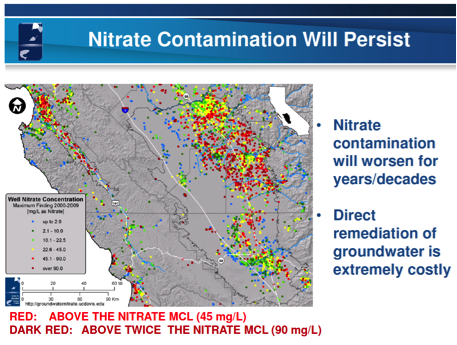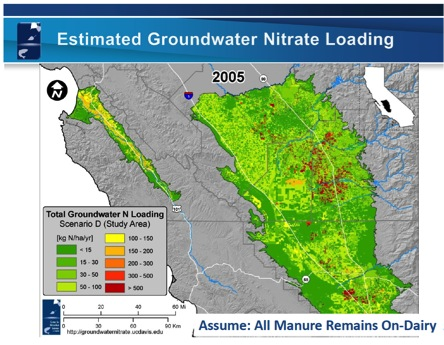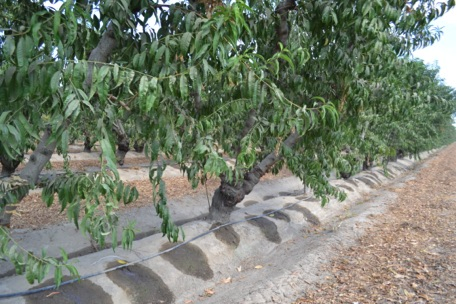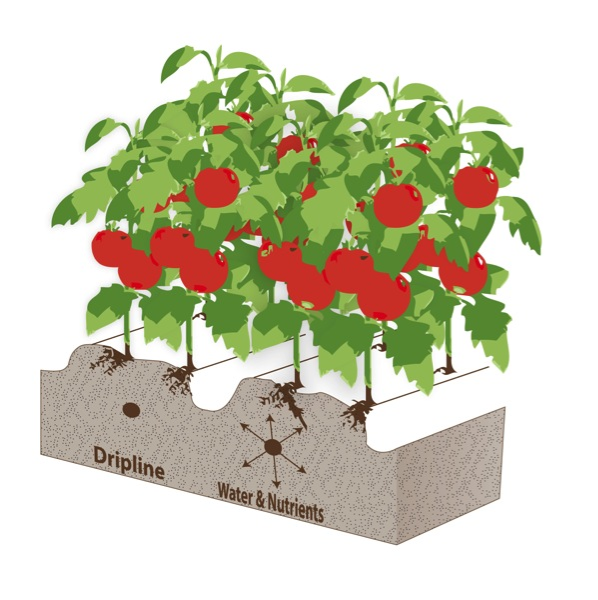

http://groundwater.ucdavis.edu
California farmers deal with complex irrigation and fertilization requirements of “specialty” crops within diverse rotations. Some of these so-called specialty crops have a farm value of more than $4 billion per year. These high-value crops demand careful management of both water and nutrients to achieve high yield and consistently high quality.
High-value crops require careful water and nitrogen management.

There is no doubt that nitrogen efficiency (fertilizer recovery) is increasing at a rapid rate. For many crops, yields have doubled or tripled in the last couple of decades while the same amount of nitrogen fertilizer has been used. Much of this is due to better agronomic practices and the switch to advanced irrigation techniques. In a dry environment such as California, nitrogen management cannot be significantly improved without simultaneous improvement in water management. Now there is a need to document these improvements and to justify current practices.
Nitrogen fertilizer regulations currently exist in two major regions of the state. Farmers are asked to keep track of all nitrogen inputs and the harvested outputs on each field. This includes:
- Soil testing for carryover nitrate from previous crops;
- Estimating the nitrogen release from crop residues, manures and organic matter;
- Having a current estimate of the nitrate concentration in irrigation water and the amount of water used; and
- Calculating the crop nitrogen demand to be met by added fertilizer for the expected yield.
The push for better nitrogen efficiency is a great opportunity for all of us to reexamine the importance of 4R Nutrient Stewardship. This involves using local expertise to guide decisions such as:
Right Source: Nitrogen fertilizers are most commonly added as nitrate, ammonium or urea. Each one of these nutrient sources behaves differently in the soil. Knowing their reactions and plant availability is a key to improving overall management.
Right Rate: This can be a difficult target to define in advance. We have good general fertilizer recommendations from university and industry experts, but fields usually have low- and high-yielding areas, and crop growth may fluctuate due to weather or other factors. Careful record keeping over multiple years will document realistic yield goals and provide a foundation for planning. Using tools such as soil nitrate testing, petiole testing and tissue testing also provides valuable feedback during the growing season to help adjust the nitrogen fertilizer application rate.
Right Time: Decide whether a preplant application of nitrogen is necessary, and understand how the crop will respond to split applications of fertilizer. Determine how many split applications are desirable and feasible, especially when using fertigation techniques. Know when the plant has the greatest demand for nitrogen uptake during the growing season. Applying nitrogen too early or too late can result in lost yield, reduced quality and wasted fertilizer.
Right Place: Plant nutrients need to be near the roots to be taken up. Some nitrogen forms move easily with water, while others are less mobile. If you plan to use water to move nitrogen fertilizer to the root zone, don’t over-irrigate, or the nitrate can be carried below the root zone. Crops in lower-yielding portions of the field may not require as much nitrogen as the high-yielding areas.
Subsurface irrigation optimizes the interaction between water and applied nutrients.

All the careful attention to nitrogen management will be canceled out by misapplication of irrigation water. Nitrate and urea are very soluble and move freely with water in the soil. Meeting the water demand of shallow-rooted crops while avoiding nitrate leaching is very challenging. Irrigation practices and nitrogen management are inextricably linked. More information on nitrogen fertilizer management from IPNI is available here: http://www.ipni.net/nitrogennotes
We will certainly be dealing with increased focus on nitrogen management in the years to come. Take time now to review these fundamentals so you will be ready to meet your crop nutrition needs.
About the Author
Dr. Rob Mikkelsen is the Vice President of Communications and North American Program Director for the International Plant Nutrition Institute (IPNI). Prior to his work with IPNI, he served as the Professor of Soil Science at North Carolina State University in Raleigh and Soil Chemist at the National Fertilizer Development Center in Muscle Shoals, Alabama.
Dr. Mikkelsen is well known for his research and expertise in nutrient management, and has authored and co-authored numerous publications. His research has focused on basic agronomic and fertilizer technology, as well as nutrient interactions with the environment, animal waste management, and nutrient budgets.
Dr. Mikkelsen received his B.S. degree in Agronomy/Soils at Brigham Young University, and his Ph.D. in Soil Science at the University of California, Riverside. He currently resides in Merced, California.
©2014 The Mosaic Company. All rights reserved.